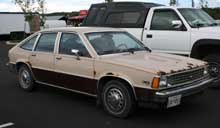In April 1979, General Motors introduced a new line of compact cars. Designated “X-bodies,” an early use of a corporate code name in automotive marketing (the predecessor X-body, the Chevrolet Nova and corporate siblings, had not used the X-word in public), the line included the Chevrolet Citation, Pontiac Phoenix, Oldsmobile Omega and Buick Skylark. The Citation and Phoenix offered a notchback coupe and two hatchback models, two- and four-door. Olds and Buick had a more formal roofline and eschewed the hatchback entirely. The base engine was a Pontiac-built 2.5-liter “Iron Duke” four. A new Chevrolet 2.8-liter 60-degree V6 was optional. A floor shift four-speed overdrive manual transmission was standard, with automatic optional.
The big news was the X-cars’ engineering: transverse-engine front-wheel drive with rack-and-pinion steering. These were not new inventions. The British Motor Corporation’s Mini, designed by Alec Issigonis, used them from 1959, and the concept wasn’t even new in the United States. J. Walter Christie had built and raced a number of cross-engine front-wheel drive cars prior to 1910. But it was novel in the 1980 model year, when all the American competition was mired in longitudinal front-engine rear-drive configuration.
Chevrolet touted the Citation’s advantage in bad weather, which it had aplenty, and also suggested it was good for towing, which it really wasn’t. It’s quaint to look back and see how the features we take for granted today, power windows, heated backlights, moonroofs, and reclining seats, were touted options. Kitschy fake wire wheels were still in vogue, and instrument panels sported round dials in rectangular frames and vertical radio controls.
Of course there was a sport model, designated X-11, which was largely an appearance package with alloy wheels, although “bucket seats” (more like ordinary seats with bolsters), a high-output V6 and sport suspension made it more lively. A sport steering wheel and tachometer completed the package.
The X-cars got a roaring reception, and a long waiting list developed. Soon, however, the cars’ teething problems became apparent. The power steering and brakes were problematic, the latter causing uncontrollable lockup under hard use. Eventually the engineering caught up with the concept, but not before the brand had been tarnished. A former co-worker of mine had an Olds Omega that was so bad it became a cause celebre for the Connecticut lemon law.This last generation of X-cars was ushered out after 1985, but the lessons learned were factored into a new line of front-wheel drive A-body intermediates, the Chevy Celebrity, Pontiac 6000, Olds Cutlass Ciera and Buick Century in 1982. For all their faults, the X-cars really paved the road for volume production of front-wheel drive in America.
The X-cars have yet to make much of a dent in the collector marketplace. Most of the survivors are weathered veterans like this Citation. However, last October’s Hershey had a decent example in the Car Corral, whose only obvious flaw was a scarred bumper fill panel. Moreover, some brave souls are entering serious competition. Wayne Kieffer’s 1980 Buick Skylark has achieved Preservation status at AACA.

